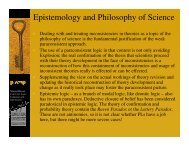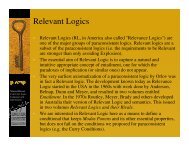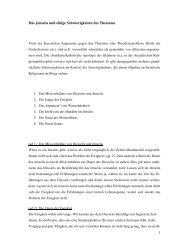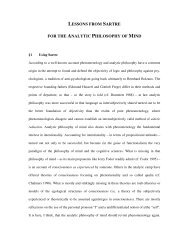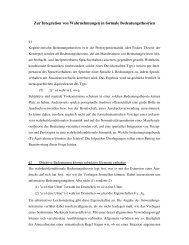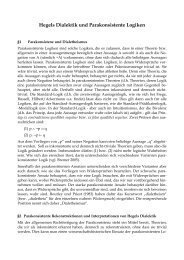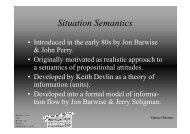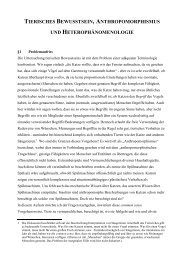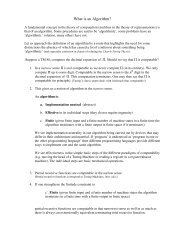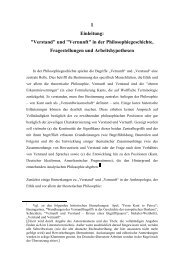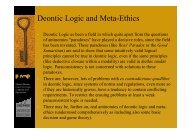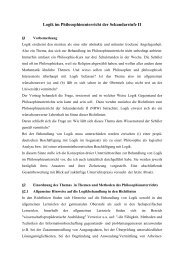Inconsistent Ontology - Mbph.de
Inconsistent Ontology - Mbph.de
Inconsistent Ontology - Mbph.de
You also want an ePaper? Increase the reach of your titles
YUMPU automatically turns print PDFs into web optimized ePapers that Google loves.
p ∧¬<br />
∧¬ ∧¬p ∧¬<br />
∧¬<br />
Manuel Bremer<br />
Centre for Logic,<br />
Language and<br />
Information<br />
<strong>Inconsistent</strong> <strong>Ontology</strong><br />
• An ontology of inconsistent objects is – in my eyes – the greatest<br />
challenge of/to paraconsistent mathematics and set theory.<br />
• Given the strong paraconsistent program of true contradictions and a<br />
even mildly realistic theory of truth (containing in some – maybe even<br />
restricted – fashion the i<strong>de</strong>a of correspon<strong>de</strong>nce), a true contradiction is<br />
supposedly ma<strong>de</strong> true by either an inconsistent fact (taking facts – at<br />
least for the moment – to be truth makers of statements) or by<br />
inconsistent objects. Like true contradictions they are just there.<br />
• The challenge may not be that great for Naive Semantics given some<br />
mildly anti-realistic theory of truth (containing in some – maybe even<br />
restricted – fashion the i<strong>de</strong>a that truth <strong>de</strong>pends on justification), and<br />
observing that the inconsistent objects in that area are sentences only.<br />
• The real problem are objects like the Russell set or the least<br />
inconsistent number. Isn't that too much to bear, even for a dialetheist?<br />
• The most famous theory in the field is Meinong's ontology of possible,<br />
of inconsistent and of impossible objects, and their mo<strong>de</strong>s of being.
p ∧¬<br />
∧¬ ∧¬p ∧¬<br />
∧¬<br />
Manuel Bremer<br />
Centre for Logic,<br />
Language and<br />
Information<br />
<strong>Inconsistent</strong> <strong>Ontology</strong> and Realism<br />
• As a realist – even if you do not adhere to naive realism or extreme<br />
versions of metaphysical realism – you adhere to some principle that<br />
there correspond structured entities (facts or objects with properties) to<br />
true statements. The entities are – at least as much as our linguistic<br />
resources to <strong>de</strong>scribe them are partly sufficient – as the true statements<br />
say they are.<br />
• This means that a truth like F(a) ∧ ¬F(a) means at first sight that the<br />
object a has property F and does not have property F. On second sight<br />
we worked with the i<strong>de</strong>a of an extension of "F( )" and an antiextension<br />
of "F( )", the extension being the set of entities fulfilling the<br />
criteria of F-ness, and thus being F; and the anti-extension being the set<br />
of entities fulfilling criteria of not being F, thus being not-F.<br />
• For an anti-realist this may solve the problem of inconsistent objects,<br />
since being an inconsistent objects means nothing more for an antirealist<br />
than that the objects fulfills inconsistent criteria. There is no<br />
claim on the anti-realist's si<strong>de</strong> that there corresponds something to this<br />
in reality.
p ∧¬<br />
∧¬ ∧¬p ∧¬<br />
∧¬<br />
Manuel Bremer<br />
Centre for Logic,<br />
Language and<br />
Information<br />
<strong>Inconsistent</strong> <strong>Ontology</strong> and Realism (II)<br />
• The anti-realist can even explain how this may happen in case of<br />
ordinary objects: If predicates are employed to more or the less vague<br />
criteria or family resemblances to some prototype it may happen that<br />
one route of resemblance leads from the prototype of F to a, and<br />
another route leads via some intermediaries from a to a prototype of<br />
non-F. In the manner of weak paraconsistency one may argue that we<br />
have to be able to mo<strong>de</strong>l theories that <strong>de</strong>pict – at least implicitly – the<br />
world as containing inconsistent objects without ourselves to be<br />
committed to this picture. We need the formal tools (like LPQ) for<br />
this, but these tools themselves have no negative ontological impact.<br />
That is just like we need a logic to draw inferences in works of fiction<br />
(or about art) where some works are essentially inconsistent with<br />
respect to some object (e.g., some stories about time travelling or<br />
drawings by M. C. Escher).<br />
• A realist cannot take this easy way out. For (most) realists properties<br />
are structures of objects – or parts or tropes... – and either you have<br />
them or not.
p ∧¬<br />
∧¬ ∧¬p ∧¬<br />
∧¬<br />
Manuel Bremer<br />
Centre for Logic,<br />
Language and<br />
Information<br />
<strong>Inconsistent</strong> <strong>Ontology</strong> and Realism (III)<br />
• In case of sentences – i.e. for a dialetheist view on naive semantics –<br />
the way out may be that a sentence is really an object that can have<br />
inconsistent properties without us having ontological scruples: A<br />
sentence being a dialetheia means that itself and its negation are<br />
provable. These are clear cut properties.<br />
• What about the content of the dialetheia? If the Liar is really true there<br />
has to be some fact corresponding to this truth!<br />
• The content of the semantic antinomies, once again, concerns facts<br />
about language. Given our mild form of realism that incorporates<br />
some i<strong>de</strong>a that truth is also – besi<strong>de</strong>s aiming at correspon<strong>de</strong>nce – tied<br />
to justification we can accept inconsistent objects here, since this<br />
"merely" points to the inconsistent nature of our linguistic access to<br />
reality. That is a <strong>de</strong>ep philosophical point – as dialetheism is – but it<br />
locates the inconsistent objects somewhere in the objects having the<br />
job of mediating between our mind and the rest of reality, these objects<br />
often being constituted by linguistic conventions.
p ∧¬<br />
∧¬ ∧¬p ∧¬<br />
∧¬<br />
Manuel Bremer<br />
Centre for Logic,<br />
Language and<br />
Information<br />
<strong>Inconsistent</strong> <strong>Ontology</strong> and Realism (IV)<br />
• The problem of inconsistent objects is much har<strong>de</strong>r with respect to<br />
ordinary objects. If properties are structures of objects, and this means<br />
in the last analysis structures of distribution of matter and energy, then<br />
an inconsistent objects cannot exist, it seems, since either at some<br />
location there is matter or not.<br />
• For a dialetheist the problem is naive set theory, given one is a realist<br />
about sets. A set, it seems, either is a member of another set or it is not,<br />
otherwise the including set could not be well-<strong>de</strong>fined.
p ∧¬<br />
∧¬ ∧¬p ∧¬<br />
∧¬<br />
Manuel Bremer<br />
Centre for Logic,<br />
Language and<br />
Information<br />
Meinong's <strong>Ontology</strong><br />
• The most promising place to turn to for an ontology of inconsistent<br />
objects is Alexius Meinong's Gegenstandstheorie. The logic of<br />
Meinong's ontology has to be, it seems, some kind of paraconsistent<br />
logic; and strong paraconsistent semantics may need something like<br />
Meinong's ontology. Thus the focus in this chapter is on Meinong's<br />
ontology and its formalisation by analytic philosophers.<br />
• Meinong's theory has been ridiculed by analytic philosophers from<br />
Russell to Ryle. The i<strong>de</strong>a of there being an object for any name or<br />
<strong>de</strong>scription (including the gol<strong>de</strong>n mountain or the round square) seems<br />
too strange.<br />
• There has been a growing interest in Meinong's theory, however, with<br />
the advent of Free Logics (logics that allow for individual expressions<br />
that do not refer) and the intricacies of the semantic and logical<br />
analysis of context of belief. The logic of fictional objects also can be<br />
hardly referential. Semantics of modal logics talk about different<br />
mo<strong>de</strong>s of being (being actual, i.e. part of the actual world, vs. being<br />
merely possible) – so there may be a relationship to Meinong's i<strong>de</strong>as.
p ∧¬<br />
∧¬ ∧¬p ∧¬<br />
∧¬<br />
Manuel Bremer<br />
Centre for Logic,<br />
Language and<br />
Information<br />
Meinong's <strong>Ontology</strong> (II)<br />
• In Meinong's theory are – in sense of "are" to be explained" – all<br />
objects. There are also inconsistent and impossible objects.<br />
• With inconsistent objects there seem to be inconsistencies, since the<br />
round square is round and is square, thus round and not-round.<br />
• Meinong himself did not <strong>de</strong>velop a logic to <strong>de</strong>al with inconsistent<br />
objects. He saw standard logic as fit for existing objects (these are the<br />
objects in space and time). <strong>Inconsistent</strong> objects are for him, because of<br />
their inconsistency, impossible objects (i.e. it is impossible that they<br />
exist [somewhere in space and time]).<br />
• Meinong's basic i<strong>de</strong>a is the rejection of any inherent connection<br />
between having properties (i.e. predication) and existence (i.e.<br />
metaphysics, in Meinong's use of the term). [This i<strong>de</strong>a can be spelled<br />
out into several theses – to be explored shortly.]<br />
• The point of attack is the Ontological Assumption saying<br />
(OA) Predication implies existence.<br />
or the Referential Assumption saying<br />
(RA) Every singular term refers to some kind of being.
p ∧¬<br />
∧¬ ∧¬p ∧¬<br />
∧¬<br />
Manuel Bremer<br />
Centre for Logic,<br />
Language and<br />
Information<br />
Noneism<br />
• This attack on the Ontological and the Referential Assumption is<br />
generalised by Richard Routley (1979a) into noneism.<br />
• Noneism is the theory of non-being. Meinong's more fundamental i<strong>de</strong>a<br />
– behind his attack on (OA) and (RA) – is the claim that objects are<br />
beyond being. That i<strong>de</strong>a is supposedly hard to grasp.<br />
• Meinong does not claim that there are realms of being besi<strong>de</strong>s being in<br />
space and time (i.e. existence). There are no domains of possibilia<br />
(possible objects). And there are no "outer-domains" (like in some Free<br />
Logics) where even more strange objects like the round square resi<strong>de</strong>.<br />
• Meinong claims that objects are without being! The philosophical field<br />
that <strong>de</strong>als with objects in this generality is Gegenstandstheorie [Object<br />
Theory] (whereas metaphysics is concerned with existents only).<br />
• "Noneism" is a name to Meinong's claim. Noneism claims, for<br />
example, that mathematics does not <strong>de</strong>al with anything having being;<br />
so there is no problem of abstract entities: numbers etc. are objects and<br />
nothing beyond that. The same goes for sets and properties (if taken as<br />
abstract entities). Noneism is the alternative to Platonism, it claims.
p ∧¬<br />
∧¬ ∧¬p ∧¬<br />
∧¬<br />
Manuel Bremer<br />
Centre for Logic,<br />
Language and<br />
Information<br />
Noneism (II)<br />
• Noneism goes beyond a dual aspect theory of meaning (that separates<br />
sense/meaning from reference), since it sees in such dual aspect<br />
theories only a version of (RA) in that these theories take (as in Frege)<br />
the sense sometimes as the referent of an expression.<br />
• Any kind of shifting (like in Frege) or using intensions in intensional<br />
contexts (like in Carnap) is said to less a<strong>de</strong>quate to our un<strong>de</strong>rstanding<br />
of intensional contexts than a straightforward noneism such that<br />
(1) Peter believes Holmes to live in Bakerstreet.<br />
expresses a relation between Peter and (the object) Holmes.<br />
• Objects can be quantified; there will be different kind of quantifiers<br />
though – some with existential impact, others not.
p ∧¬<br />
∧¬ ∧¬p ∧¬<br />
∧¬<br />
Manuel Bremer<br />
Centre for Logic,<br />
Language and<br />
Information<br />
Postulates of Noneism<br />
• Noneism can be characterised by a set of postulates:<br />
(P1) Everything is an object.<br />
(P2) Many objects have no way of being.<br />
(P3) Nonexistent objects have properties and are constituted<br />
in some way.<br />
(P4) Existence is no characteristic property of an object.<br />
(P5) Every object has an essence in<strong>de</strong>pen<strong>de</strong>nt of its<br />
existence.<br />
(P6) Every object has its characterising properties.
p ∧¬<br />
∧¬ ∧¬p ∧¬<br />
∧¬<br />
Manuel Bremer<br />
Centre for Logic,<br />
Language and<br />
Information<br />
Postulates of Noneism (II)<br />
• These postulates have some immediate consequences:<br />
- by (P1) anything can be the object of belief, <strong>de</strong>sire, fear – any<br />
propositional attitu<strong>de</strong> – whether the object is possible or impossible.<br />
- by (P6) – also called the Characterisation Postulate – the gol<strong>de</strong>n<br />
mountain is gol<strong>de</strong>n, and the round square is round and is square.<br />
- by (P4) versions of the ontological proof of God's existence should be<br />
blocked.<br />
- by (P3) and (P5) the round square and the triangular square are<br />
different impossible objects.<br />
- by (P5) and the existence of impossibilia we can say:<br />
(2) There is something which necessarily does not exist.<br />
The first quantifier having no existential impact here.<br />
• Postulate (P3) is called the Principle of In<strong>de</strong>pen<strong>de</strong>nce. As a universal<br />
claim it is the contrary to (OA).<br />
• The Characterisation Postulate is a further claim to the well <strong>de</strong>fined<br />
nature of nonexistents. It allows to draw modal conclusions (like (2))<br />
from the <strong>de</strong>finition of an object.
p ∧¬<br />
∧¬ ∧¬p ∧¬<br />
∧¬<br />
Manuel Bremer<br />
Centre for Logic,<br />
Language and<br />
Information<br />
Noneism and Intensional Contexts<br />
• As mentioned above, by (P1) anything can be the object of belief,<br />
<strong>de</strong>sire, fear – any propositional attitu<strong>de</strong> – whether the object is possible<br />
or impossible. The attitu<strong>de</strong> is directed to the object itself, not to its<br />
representation or to the sense of the object's name.<br />
• And given that we have quantifiers at our disposal that carry no<br />
ontological commitment we can freely quantify into intensional<br />
contexts:<br />
(3) Peter thinks of the round square.<br />
(4) (∃x)(Peter thinks of x)<br />
goes through.<br />
• [Note that the failure of substitutivity in intensional contexts still obtains in<br />
noneism: If<br />
(5) The round square is Meinong's famous example for an<br />
impossible object.<br />
we still need not have that (6) is true if (3) is true, given Peter's ignorance:<br />
(6) Peter thinks of Meinong's famous example for an<br />
impossible object.]
p ∧¬<br />
∧¬ ∧¬p ∧¬<br />
∧¬<br />
Manuel Bremer<br />
Centre for Logic,<br />
Language and<br />
Information<br />
Talking about Nonexistents<br />
• The postulates have some immediate consequences as well for our way<br />
of using arbitrary individual expressions.<br />
• We can recast the Postulate of In<strong>de</strong>pen<strong>de</strong>nce as a statement about<br />
sentences [cf. Routley 1979a, p. 14]:<br />
(P3') Sentences about singular objects have meaning<br />
in<strong>de</strong>pen<strong>de</strong>nt from the existence or the possibility of<br />
these objects.<br />
(P3'') Many sentences about nonexistents have a truth value.<br />
• Not every sentence about a nonexistent object has a truth value, since<br />
nonexistents are in most cases only partially characterised. We do not<br />
know how many rolls Holmes ate during his observation of the<br />
Baskervilles. (So a noneist logic may allow for truth value gaps.)<br />
• [Note that (P3') and (P3'') are true in many Free Logics as well, cf. (Lambert<br />
1991). The distinguished nature of noneism is due to postulates (P1), (P2),<br />
(P5) and (P6).]
p ∧¬<br />
∧¬ ∧¬p ∧¬<br />
∧¬<br />
Manuel Bremer<br />
Centre for Logic,<br />
Language and<br />
Information<br />
Talking about Nonexistents (II)<br />
• Assertaining which properties an existent has may be observable or be<br />
based on observation. Which properties a nonexistent has has to be<br />
<strong>de</strong>termined differently.<br />
• Whatever can be said with truth value (be it "true" or "false") about<br />
nonexistents can only be due to their <strong>de</strong>finitions (as in the case of the<br />
round square) or due to the story told about them (as in the case of<br />
Holmes).<br />
• So what we have here is basically a way to get sentences from other<br />
sentences. We do not access objects of any kind.<br />
• Given that we already have the <strong>de</strong>finitions or the stories before us, all<br />
these sentences about nonexistents have their truth value a priori.
p ∧¬<br />
∧¬ ∧¬p ∧¬<br />
∧¬<br />
Manuel Bremer<br />
Centre for Logic,<br />
Language and<br />
Information<br />
Meinongian Logic<br />
• The logic corresponding to Meinong's ontology cannot be a standard<br />
logic because of the presense of inconsistent objects.<br />
• It cannot, as well, be a paraconsistent logic in which Tertium Non<br />
Datur holds, since Meinong allows not only for inconsistent, but also<br />
for incomplete objects (i.e. objects such that there is some property P<br />
such that neither P nor ¬P are true of them) – unless one introduces a<br />
distinction between sentence negation and predicate negation. Then<br />
Tertium Non Datur may hold for sentence negation (the nonapplication<br />
of the property making the negated sentence true), but not<br />
for predicate negation. Given two negations one needs to know what<br />
interrelations hold between these negations. Does, for example,<br />
¬~P(a)≡P(a) hold? There has to be some logic for predicate negation if<br />
it is not just a tool of introducing additional predicates. Further on one<br />
may won<strong>de</strong>r whether natural languages have these two negations.<br />
• If one kept a single negation the logic of Meinongian ontology might<br />
be some 4-valued logic like BN4 [cf. Chap. 9] or FDE [cf. Chap 5].
p ∧¬<br />
∧¬ ∧¬p ∧¬<br />
∧¬<br />
Manuel Bremer<br />
Centre for Logic,<br />
Language and<br />
Information<br />
Assessment of Noneism<br />
• Dialetheism in semantics needs no special ontology of inconsistent<br />
objects if the inconsistencies are located within our linguistic<br />
frameworks. That a sentence can be shown to be true and can be<br />
shown to be not true points to the fact of inconsistent evaluations or<br />
<strong>de</strong>rivations, but to no <strong>de</strong>ep ontological mystery.<br />
• <strong>Inconsistent</strong> theories in the sciences can be un<strong>de</strong>rstood in the sense of<br />
weak paraconsistency, i.e. they may be mo<strong>de</strong>lled by LPQ-style<br />
quantificational semantics with inconsistent objects, but one does not<br />
believe that there really are these objects.<br />
• You really need an ontology of inconsistent objects if you are a<br />
mathematical realist and your favourite mathematics is inconsistent, or<br />
if you are a dialetheist in a set theory, again taken realistically.<br />
• You can have a dialetheist set theory with inconsistent objects if you<br />
are a noneist. Noneism in <strong>de</strong>nying being to inconsistent objects is,<br />
however, to weak as foundation of paraconsistent set theory, since sets<br />
– unless you believe in noneism – are usually taken to exist (even if<br />
not in space in time). Noneism certainly is no version of realism.
p ∧¬<br />
∧¬ ∧¬p ∧¬<br />
∧¬<br />
Manuel Bremer<br />
Centre for Logic,<br />
Language and<br />
Information<br />
Assessment of Noneism (II)<br />
• Noneism is either a version of a substitutional un<strong>de</strong>rstanding of<br />
individual expressions (such that we can use a non-referring expression<br />
and tell a story in which this expression occurs [for example a story<br />
about a unicorn]) in which case intensional contexts are to be<br />
un<strong>de</strong>rstood in some way paratactically [in the tradition of Carnap's<br />
intensional isomorphy or Davidson's saying that],<br />
– or noneism is not comprehensible at all.<br />
• The distinction between existents and possibilia is a clear one in modal<br />
semantics. Noneism claims even less being than possible being, but<br />
still uses the forms of "to be".<br />
– What an object beyond all being is supposed to be, is beyond me.<br />
• The In<strong>de</strong>pen<strong>de</strong>nce Thesis seems at least in its noneist reading quite<br />
questionable. BeingRound in case of the non-being round square<br />
cannot be the same manner of being round like in the case of a penny<br />
coin, BeingGold in case of the non-being gol<strong>de</strong>n mountain cannot be<br />
the same manner of being gol<strong>de</strong>n (i.e. having some physical structure)<br />
like in the case of the gold bar. General terms seem to become<br />
ambiguous here!
p ∧¬<br />
∧¬ ∧¬p ∧¬<br />
∧¬<br />
Manuel Bremer<br />
Centre for Logic,<br />
Language and<br />
Information<br />
What Do We Need "Items" for?<br />
• The main argument that in any context we need an "item" to be talked<br />
about is not convincing. Given a dual aspect theory of meaning (i.e.,<br />
reference vs. meaning in the narrow sense) some talk may have no<br />
referent, but still has meaning. Referentially it is about nothing, but we<br />
can rephrase the content of such talk. Giving this content does not<br />
presuppose an "item" that these sentences are "about".<br />
• In Free Logic we are free to use any singular term we like. It just may<br />
turn out that it does not refer. This accounts for the free use of names<br />
and <strong>de</strong>scriptions in ordinary discourse. We do not need the – further –<br />
assumption that everytime we use an expression that might refer to an<br />
object there "is" some object, although it might be non-existent and<br />
completely without being. Even allowing possibilia (or ersazist<br />
possibilia) that subsist without having physical existence may do a<br />
better job in a Free Logic framework than inventing non-being.<br />
• So, if we are interested in inconsistent ontology this may be not<br />
because we have some use for inconsistent objects (apart from<br />
sentences) somewhere in philosophy, but because we are forced to<br />
consi<strong>de</strong>r ways to have inconsistent objects by our adherence to Naive<br />
Set Theory.
p ∧¬<br />
∧¬ ∧¬p ∧¬<br />
∧¬<br />
Manuel Bremer<br />
Centre for Logic,<br />
Language and<br />
Information<br />
The Logic of Encoding Framework<br />
• If one believes in abstract entities the problem of inconsistent objects<br />
seems to be less pressing, since anything may go on in that realm.<br />
• A major alternative to noneism is Zalta's Logic of Encoding (LoE),<br />
which is an axiomatized ontology of abstract entities based on Second<br />
Or<strong>de</strong>r Modal Logic. LoE <strong>de</strong>als with several philosophical topics (like<br />
intentional contexts), but we look here just at its sub-theory of<br />
inconsistent objects and its way of interpreting/using Meinong's i<strong>de</strong>as.<br />
• The central i<strong>de</strong>a of LoE is the distinction between exemplification and<br />
encoding [following Meinong's pupil Ernst Mally].<br />
• Exemplification is that way of ordinary predication in which a red pen is<br />
said to exemplify the property BeingRed. Encoding in distinction to this<br />
is the way abstract entities are <strong>de</strong>termined. An abstract entity is the<br />
specific abstract entity it is by encoding some specific properties. The<br />
crucial point is that an abstract entity need not exemplify the properties<br />
it enco<strong>de</strong>s.<br />
• Example: The gol<strong>de</strong>n mountain enco<strong>de</strong>s the properties of BeingGol<strong>de</strong>n<br />
and BeingMountain (these encoding facts make up this specific abstract<br />
entity), but it need not exemplify these properties! An abstract entity has<br />
no more need to exemplify the properties it enco<strong>de</strong>s, as a representation<br />
of a lake needs to be wet.
p ∧¬<br />
∧¬ ∧¬p ∧¬<br />
∧¬<br />
Manuel Bremer<br />
Centre for Logic,<br />
Language and<br />
Information<br />
The Logic of Encoding Framework (II)<br />
• The LoE framework thus <strong>de</strong>nies the In<strong>de</strong>pen<strong>de</strong>nce Thesis (which now<br />
would cross illicitly from encoding to exemplification anyway).<br />
• Several kinds of abstract entities exist (individuals, properties, relations,<br />
propositions).<br />
• These abstract entities play all the roles items play in noneism.<br />
• To have enough abstract entities around a principle of comprehension<br />
claiming that there is an encoding abstract entity to any property is<br />
postulated.<br />
• To avoid paradoxes encoding is generally restricted to first or<strong>de</strong>r<br />
properties with a finite number of <strong>de</strong>finitionally introduced exceptions.<br />
• For Meinongianism this means:<br />
- there are abstract objects which enco<strong>de</strong> contradictory properties<br />
- since these objects need not exemplify the properties they enco<strong>de</strong><br />
there are no true contradictions because of these objects<br />
- the un<strong>de</strong>rlying logic, thus, can be (exten<strong>de</strong>d) standard logic.
p ∧¬<br />
∧¬ ∧¬p ∧¬<br />
∧¬<br />
Manuel Bremer<br />
Centre for Logic,<br />
Language and<br />
Information<br />
The Logic of Encoding<br />
• To give you some i<strong>de</strong>a of the formal LoE we may look at some of its<br />
ingredients:<br />
• First of all it distinguishes exemplification formula [F(a)] from encoding<br />
formula [aF].<br />
• If a enco<strong>de</strong>s F then a necessarily enco<strong>de</strong>s F: xF ⊃ xF<br />
• The logic uses quantified S5 modal logic (quantifying also over<br />
properties, where properties may be build by λ-abstraction) with i<strong>de</strong>ntity<br />
and <strong>de</strong>scriptions which <strong>de</strong>signate rigidly and need not refer at all (using<br />
the usual precautions with respect to this dangerous combination).<br />
• "E!( )" is used as an existence predicate with the inten<strong>de</strong>d meaning<br />
"existing in space-time".<br />
• The ordinary objects are the existing objects. They are i<strong>de</strong>ntical iff they<br />
necessarily exemplify the same properties:<br />
(∀x,y)(O!(x) ∧ O!(y) ⊃ (x = y ≡ (∀F)(F(x) ≡ F(y))))<br />
• Abstract objects are objects x that cannot exist in space-time: ¬ E!(x)<br />
Abstract objects are i<strong>de</strong>ntical iff they enco<strong>de</strong> the same properties:<br />
(∀x,y)(A!(x) ∧ A!(y) ⊃ (x = y ≡ (∀F)(xF ≡ yF)))<br />
Two properties are i<strong>de</strong>ntical iff they are enco<strong>de</strong>d by the same objects.
p ∧¬<br />
∧¬ ∧¬p ∧¬<br />
∧¬<br />
Manuel Bremer<br />
Centre for Logic,<br />
Language and<br />
Information<br />
The Logic of Encoding (II)<br />
• The quantifiers range of single fixed domains of individuals or<br />
properties. Therefore the Barcan Formula holds: (∀x) Fx ⊃ (∀x)Fx<br />
• The essential axioms are principles of comprehension:<br />
(∃x)(A!(x) ∧(∀F)(xF ≡ A))<br />
where A does not contain "x" free<br />
So for every condition on properties (especially their combination by<br />
disjunction) there is an abstract object that enco<strong>de</strong>s just these properties.<br />
• Given this axiom one can prove that abstract <strong>de</strong>scription always refer:<br />
(∃y)( y = ιx(A!(x) ∧(∀F)(xF ≡ A))<br />
• For exemplification a comprehension principle can be <strong>de</strong>rived by<br />
necessitation and existential generalization:<br />
(∃F) (∀x)(F(x) ≡ A)<br />
where "F" is not free in A, which does not contain encoding<br />
formula or <strong>de</strong>scriptions.<br />
[The restrictions, which also apply to abstraction, are nee<strong>de</strong>d to prevent<br />
antinomies of encoding and comprehension.]
p ∧¬<br />
∧¬ ∧¬p ∧¬<br />
∧¬<br />
Manuel Bremer<br />
Centre for Logic,<br />
Language and<br />
Information<br />
The Logic of Encoding – Assessment<br />
• One may assess the Logic of Encoding on several accounts.<br />
• Whether it is the best theory to <strong>de</strong>al with intensionality (its main<br />
concern) cannot be ma<strong>de</strong> out here, since this required extensive<br />
comparisons with rival approaches. Intensionality is not our main<br />
concern here, anyway.<br />
• Whether one should accept an ontology of abstract entities is another<br />
difficult question raising problems in epistemology and ontology (e.g.<br />
whether we need sets or classes in distinction to heaps or tropes …).<br />
This isn't our main concern here either. Given, however, that one allows<br />
for abstract entities one has the option to introduce a relation like<br />
encoding. And this may very well be a better way to make sense of<br />
Meinongianism than noneism.<br />
• Whether LoE is an alternative to dialetheism is a completely different<br />
topic. Zalta claims that his framework is an alternative. The point,<br />
however, is – again – that the framework can <strong>de</strong>al with some antinomies<br />
without yielding new ones only because its expressive power (e.g. with<br />
respect to encoding) has been artificially curtailed in a version of<br />
restricted comprehension. Furthermore, the theory does not contain its<br />
own meta-theory, which is expressed set-theoretically, as Zalta admits<br />
himself. This needs further study.
p ∧¬<br />
∧¬ ∧¬p ∧¬<br />
∧¬<br />
Manuel Bremer<br />
Centre for Logic,<br />
Language and<br />
Information<br />
<strong>Inconsistent</strong> <strong>Ontology</strong> Again<br />
• What have we seen so far?<br />
• Given our philosophical agenda of integrating Naïve Semantics and<br />
Naïve Set Theory into our logical semantic framework we cannot settle<br />
for restricted means of expression (like the Logic of Encoding).<br />
• Given the supposedly hard to swallow consequences of noneism it<br />
cannot be taken in its pure form either, it seems.<br />
• Maybe – embracing abstract entities – there is a paraconsistent version<br />
of the Logic of Encoding which commits us only to its rather harmless<br />
pseudo-impossibilia while providing us with dialethic universality.<br />
• Again [cf. the first sli<strong>de</strong>s in this chapter and Chap. 11] one might retract on<br />
the philosophical agenda: Universalism in semantics and epistemology I<br />
take to be far more important than sticking to Naïve Set Theory. One<br />
might be a dialetheist in semantics, but a proponent of some consistent<br />
sets + classes theory in axiomatic ontology, accepting some version of<br />
NBG set theory or Brady's theory of classes. The problem with the<br />
MYSTERY [cf. Chap. 2] may seem less troubling in the set/classes-case<br />
than in semantics and epistemology.<br />
– One shouldn't give up on Naïve Set Theory, however, so quickly.
p ∧¬<br />
∧¬ ∧¬p ∧¬<br />
∧¬<br />
Manuel Bremer<br />
Centre for Logic,<br />
Language and<br />
Information<br />
Questions<br />
• (Q1) Why can we say that the basic First Or<strong>de</strong>r principle of<br />
noneism is: F(ιxF(x))?<br />
• (Q2) Noneism claims that mathematics is a "just so" story<br />
about objects that have no way of being. What are the<br />
fundamental epistemological and ontological problems<br />
of this view, especially in light of the usage of<br />
mathematics in the sciences?<br />
• (Q3) In the Logic of Encoding the i<strong>de</strong>ntity of abstract objects<br />
is not <strong>de</strong>fined by having two candidates x, y exemplify<br />
the same properties, but by having x, y enco<strong>de</strong> the same<br />
properties. Why is this crucial and unavoidable?
p ∧¬<br />
∧¬ ∧¬p ∧¬<br />
∧¬<br />
Manuel Bremer<br />
Centre for Logic,<br />
Language and<br />
Information<br />
Exercises<br />
• (Ex1) Prove in LoE: ¬(∃x)(O!(x) ∧ A!(x))<br />
• (Ex2) Without the restrictions on λ-abstraction and<br />
comprehension one could assert the existence of an<br />
abstract object a that enco<strong>de</strong>s the following property:<br />
(∃x)(A!(x) ∧ (∀F)(xF ≡ F = [λx(∃F)(xF ∧ ¬Fx)]))<br />
Go with a through the cases of the ensuing antinomy!
p ∧¬<br />
∧¬ ∧¬p ∧¬<br />
∧¬<br />
Manuel Bremer<br />
Centre for Logic,<br />
Language and<br />
Information<br />
Further Reading<br />
• On the wisdom of the middleway in matters of realism between<br />
(extreme) metaphysical realism and i<strong>de</strong>alism cf. (Bremer 1999a, 2000).<br />
• Meinong's theory is presented in his Über Gegenstandstheorie<br />
(Leipzig, 1904 [in the volume Untersuchungen zur Gegenstandstheorie<br />
und Psychologie]) and Über Annahmen (Leipzig, 1902).<br />
• A monograph on the In<strong>de</strong>pen<strong>de</strong>nce Thesis alone is: Lambert, Karel.<br />
Meinong and the Principle of In<strong>de</strong>pen<strong>de</strong>nce. Cambridge et al., 1983.<br />
• Richard Routley, one of the founding fathers of paraconsistency and<br />
dialetheism, wrote a monumental monograph (1000 type scripted<br />
pages) Exploring Meinong's Jungle and Beyond (Routley 1979a)<br />
expousing not only his interpretation of Meinong's work, but also<br />
attacking the referential assumptions of standard semantics in his own<br />
right. Routley aims at a wi<strong>de</strong>r theory of noneism (and paraconsistency)<br />
• An application of Routley's logic DL to fictional discourse is argued<br />
for in: Heintz, John. "Reference and Inference in Fiction", Poetics, 8<br />
(1979), pp. 85-99.<br />
• Graham Priest provi<strong>de</strong>s his exposition of noneism in Towards Non-<br />
Being, Oxford, 2005.
p ∧¬<br />
∧¬ ∧¬p ∧¬<br />
∧¬<br />
Manuel Bremer<br />
Centre for Logic,<br />
Language and<br />
Information<br />
Further Reading (II)<br />
• An exposition on the supposed logic of Meinong's theory is: Jaquette,<br />
Dale. Meinongian Logic. Berlin/New York, 1996. Jacquette does not<br />
use a paraconsistent logic, since he distinguishes between predicate<br />
and sentence negation. The inconsistent objects just have a property<br />
and its contrary, where predicate negation is not explosive. Jacquette<br />
also uses Meinong's distinction between nuclear properties, which are<br />
part of the essence of some object, and extra-nuclear properties, which<br />
are not allowed to enter into the <strong>de</strong>finition of an object. But why<br />
should this be forbid<strong>de</strong>n? The main reason to forbid this is to avoid the<br />
resulting antinomies, it seems.<br />
• See also: Pasniczek, Jacek. "Paraconsistent vs. Meinongian Logic", in:<br />
(Carnielli/Coniglio/Ottaviano 2002), pp. 523-34.<br />
• Zalta's theory of encoding is <strong>de</strong>veloped in his book Intensional Logic<br />
and the Metaphysics of Intentionality, Cambridge, 1988. An updated<br />
version is provi<strong>de</strong>d by his web-based Principia Metaphysica. See also<br />
"A Classically-Based Theory of Impossible Worlds", Notre Dame<br />
Journal of Formal Logic, 38 (1997), pp.640-60.



